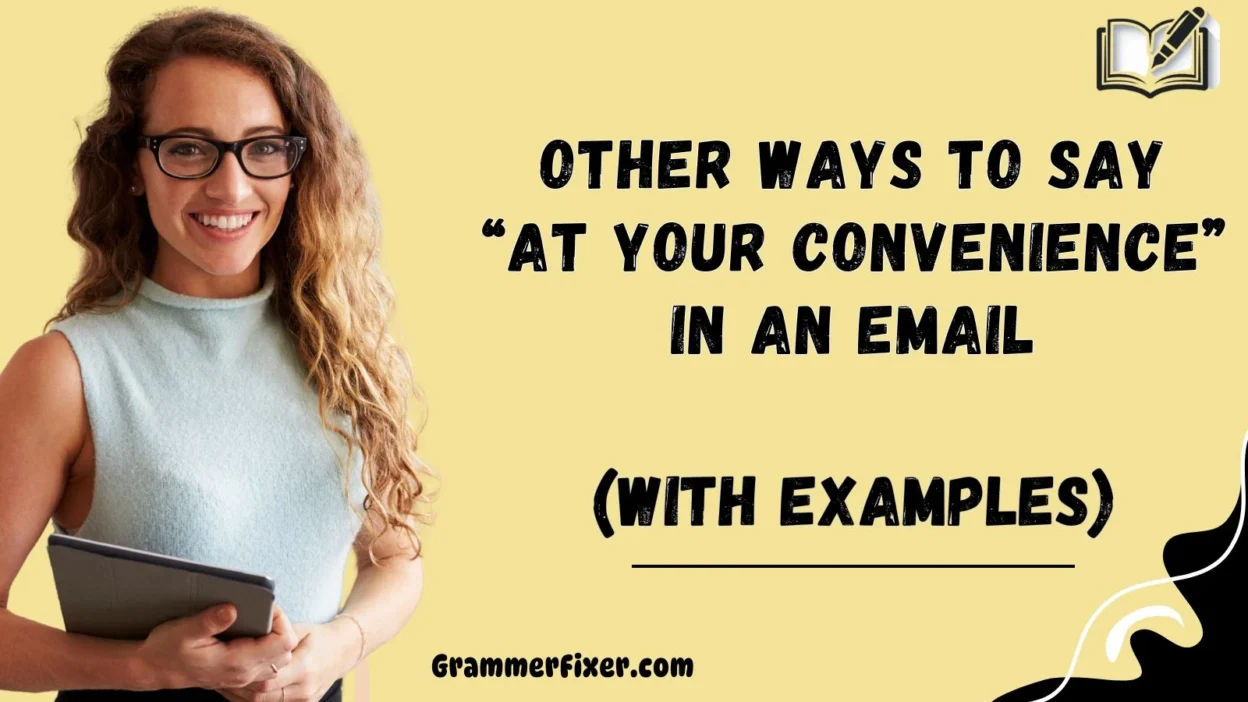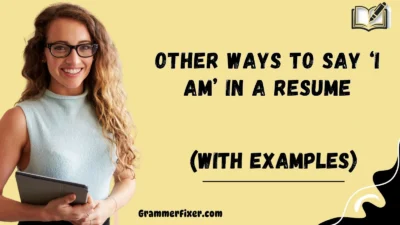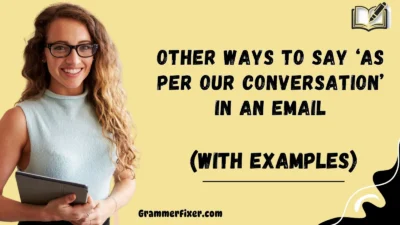Finding the right words in professional communication can be tricky. A phrase like “at your convenience” is polite and respectful, but sometimes it can feel too formal, vague, or overused. Choosing thoughtful alternatives helps you sound warmer, more considerate, and tailored to your recipient.
Below, we’ll explore 30 empathetic and professional alternatives, complete with meanings, examples, tone, and best uses, so you can make your emails more personal, respectful, and effective.
What Does “At Your Convenience” Mean?
The phrase “at your convenience” politely asks the recipient to take action whenever it best suits them, without creating a sense of urgency or pressure. It’s commonly used in emails to show respect for the recipient’s time.
When to Use “At Your Convenience”?
You can use this phrase when:
- You’re requesting information, documents, or feedback.
- You want to schedule a meeting or call without setting a strict time.
- You’re communicating with colleagues, managers, clients, or partners and wish to sound polite and professional.
Is It Professional/Polite to Say “At Your Convenience”?
Yes, it is both professional and polite. However, it can sometimes feel too vague. Without clarity, your recipient might delay replying. That’s why knowing alternatives is useful—you can soften requests while still encouraging timely action.
Pros or Cons of Using “At Your Convenience”
Pros:
- Shows politeness and respect for time.
- Works in formal and professional contexts.
- Universally understood and accepted.
Cons:
- Can feel impersonal or too formal.
- Sometimes interpreted as passive or vague.
- Might cause delays if no timeframe is given.
1. Whenever You’re Ready
Meaning: Indicates flexibility and allows the recipient to decide the timing.
Explanation: This phrase feels gentle, warm, and considerate, showing that you’re happy to wait until they’re comfortable.
Scenario Example:
“Please send me the revised file whenever you’re ready.”
Best Use: Casual conversations, friendly workplace settings.
Worst Use: Avoid in urgent tasks or where a deadline is critical—it may signal no rush at all.
Tone: Relaxed, kind, and considerate.
2. At Your Leisure
Meaning: Encourages the recipient to take their time without hurry.
Explanation: This phrase is less formal than “at your convenience” and carries a calm, patient tone.
Scenario Example:
“You may review the proposal at your leisure.”
Best Use: When asking for non-urgent tasks.
Worst Use: In time-sensitive projects where waiting could delay outcomes.
Tone: Gentle, patient, and respectful.
3. As You See Fit
Meaning: Gives control to the recipient to decide what works best.
Explanation: This phrase empowers the recipient and communicates trust in their judgment.
Scenario Example:
“Please adjust the project details as you see fit.”
Best Use: Collaborative tasks where the other person’s input matters.
Worst Use: In situations needing clear instructions—it can sound too vague.
Tone: Respectful, collaborative, and empowering.
4. When You Have a Moment
Meaning: Suggests a small time commitment when they’re free.
Explanation: This phrase feels casual yet respectful, often implying the request isn’t time-consuming.
Scenario Example:
“Could you review the attached file when you have a moment?”
Best Use: Quick reviews, small requests.
Worst Use: Avoid in urgent contexts where a specific timeframe is essential.
Tone: Polite, casual, light.
5. At a Time That Suits You
Meaning: Lets the recipient pick the best time.
Explanation: Similar to “at your convenience,” but friendlier and less rigid.
Scenario Example:
“I’d like to schedule a call at a time that suits you.”
Best Use: Setting up meetings or calls.
Worst Use: When deadlines are fixed and there’s no room for delay.
Tone: Warm, accommodating, respectful.
6. When It Works Best for You
Meaning: Centers the recipient’s schedule.
Explanation: This phrase shows consideration and a personal touch, making the recipient feel valued.
Scenario Example:
“We can go over the contract when it works best for you.”
Best Use: Clients, colleagues, or managers.
Worst Use: In fast-paced environments where prompt action is needed.
Tone: Friendly, caring, thoughtful.
7. At a Time That’s Comfortable for You
Meaning: Focuses on comfort rather than availability.
Explanation: Conveys thoughtfulness and signals that you don’t want to cause stress.
Scenario Example:
“Let’s arrange the training session at a time that’s comfortable for you.”
Best Use: Sensitive matters, supportive communication.
Worst Use: Avoid in formal business contexts with strict schedules.
Tone: Compassionate, flexible, supportive.
8. When You’re Free
Meaning: Suggests availability without pressure.
Explanation: A friendly and simple phrase that feels natural in both casual and professional settings.
Scenario Example:
“Could we discuss the project when you’re free?”
Best Use: Light, non-urgent requests where flexibility is acceptable.
Worst Use: Avoid in time-sensitive situations where specific scheduling is critical.
Tone: Relaxed, approachable, considerate.
9. At a Time That Works for You
Meaning: Puts the recipient in control of scheduling.
Explanation: Signals respect for their schedule while still implying that the meeting or task is important.
Scenario Example:
“Let’s set up the demo at a time that works for you.”
Best Use: Scheduling meetings, calls, or collaborations.
Worst Use: In urgent deadlines where there’s little flexibility.
Tone: Polite, professional, and warm.
10. At Your Earliest Convenience
Meaning: Suggests action soon but still respectfully.
Explanation: More time-sensitive than “at your convenience,” this phrase politely implies urgency.
Scenario Example:
“Please review the contract at your earliest convenience.”
Best Use: Professional emails where a timely response is needed.
Worst Use: Casual communication—it may feel too formal with friends or colleagues.
Tone: Polite, slightly urgent, formal.
11. When You Have Time
Meaning: Indicates flexibility, with no strict deadline.
Explanation: A soft phrase that communicates patience and respects the recipient’s busy schedule.
Scenario Example:
“Could you share your feedback when you have time?”
Best Use: Non-urgent requests where you don’t want to pressure the other person.
Worst Use: Avoid when deadlines or deliverables are urgent.
Tone: Gentle, patient, understanding.
12. At a Time That’s Best for You
Meaning: Emphasizes the recipient’s priorities and needs.
Explanation: This version feels empathetic and signals that you’re willing to adjust.
Scenario Example:
“I’d be happy to catch up at a time that’s best for you.”
Best Use: One-on-one meetings, supportive conversations, client communication.
Worst Use: Avoid in strictly scheduled team projects where flexibility is limited.
Tone: Empathetic, thoughtful, supportive.
13. Whenever It’s Convenient for You
Meaning: Similar to the original phrase, but warmer.
Explanation: Adds a human touch to “at your convenience,” making it feel less rigid.
Scenario Example:
“Please send your feedback whenever it’s convenient for you.”
Best Use: Polite requests that are not urgent.
Worst Use: Avoid for high-priority or time-sensitive matters.
Tone: Polite, considerate, and soft.
14. When You Get a Chance
Meaning: Suggests a light request, not pressing.
Explanation: A casual, friendly phrase that reduces pressure while still requesting action.
Scenario Example:
“Could you send me the draft when you get a chance?”
Best Use: Informal work settings or communication with colleagues you know well.
Worst Use: Formal emails with clients or executives—it may sound too casual.
Tone: Friendly, relaxed, informal.
15. At Whatever Time Works for You
Meaning: Complete flexibility for the recipient.
Explanation: Suggests that you are open to any schedule, showing accommodation and patience.
Scenario Example:
“I’m happy to review the plan at whatever time works for you.”
Best Use: Flexible collaboration and casual communication.
Worst Use: Avoid in professional high-stakes contexts where clarity and timelines matter.
Tone: Flexible, casual, supportive.
16. When It’s Most Suitable for You
Meaning: Focuses on the recipient’s suitability and comfort.
Explanation: A slightly more formal alternative that maintains politeness and respect.
Scenario Example:
“We can finalize the details when it’s most suitable for you.”
Best Use: Professional emails where you want to sound thoughtful yet formal.
Worst Use: Avoid in super casual or friendly emails—it may sound too stiff.
Tone: Polite, considerate, formal.
17. When You’re Available
Meaning: Asks the recipient to respond or act when they are free.
Explanation: This phrase is clear and respectful, often used when scheduling or requesting input.
Scenario Example:
“Please share your feedback when you’re available.”
Best Use: Scheduling meetings or asking for input without urgency.
Worst Use: Avoid if the request has a strict deadline—the phrase leaves too much flexibility.
Tone: Professional, polite, straightforward.
18. At a Time That Fits Your Schedule
Meaning: Emphasizes working around the recipient’s calendar.
Explanation: This phrase communicates respect for their workload and commitments.
Scenario Example:
“We can arrange the review session at a time that fits your schedule.”
Best Use: With colleagues, managers, or clients who have busy calendars.
Worst Use: Avoid when you need to propose a fixed time.
Tone: Respectful, considerate, accommodating.
19. Whenever It Works for You
Meaning: Grants complete freedom for the recipient to decide the timing.
Explanation: A friendly and flexible alternative that keeps the tone casual but polite.
Scenario Example:
“You can send the updated slides whenever it works for you.”
Best Use: For non-urgent matters or casual workplace interactions.
Worst Use: In formal contexts where clarity and deadlines are required.
Tone: Casual, friendly, light.
20. When It’s Most Convenient
Meaning: Suggests acting when it causes the least disruption for the recipient.
Explanation: A slightly more formal alternative that remains polite and clear.
Scenario Example:
“Let’s discuss this further when it’s most convenient.”
Best Use: Professional conversations that need politeness and respect.
Worst Use: Avoid if the timing is urgent—it can sound too lenient.
Tone: Polite, respectful, professional.
21. At a Time That’s Right for You
Meaning: Suggests the recipient can choose the most appropriate time.
Explanation: This phrase feels empathetic and thoughtful, allowing the other person to decide freely.
Scenario Example:
“I’d like to connect at a time that’s right for you.”
Best Use: One-on-one conversations where building rapport matters.
Worst Use: Avoid in group scheduling—it doesn’t consider multiple participants.
Tone: Empathetic, thoughtful, supportive.
22. When You’re Comfortable
Meaning: Prioritizes the recipient’s comfort level with timing.
Explanation: This option conveys sensitivity and avoids sounding demanding.
Scenario Example:
“Please share your insights when you’re comfortable.”
Best Use: Delicate or sensitive topics where empathy is essential.
Worst Use: Formal workplace emails with executives—it may sound too casual.
Tone: Compassionate, considerate, warm.
23. At Whatever Time You Prefer
Meaning: Hands full control of timing to the recipient.
Explanation: It communicates openness and a willingness to adapt.
Scenario Example:
“We can go over the updates at whatever time you prefer.”
Best Use: Friendly, non-urgent requests.
Worst Use: Avoid if you need quick action—it may cause unnecessary delays.
Tone: Flexible, laid-back, accommodating.
24. When It’s Feasible for You
Meaning: A polite way to ask for action when the recipient is able to manage it.
Explanation: This phrase balances professionalism with understanding of workload.
Scenario Example:
“Please provide your feedback when it’s feasible for you.”
Best Use: With colleagues or managers balancing heavy responsibilities.
Worst Use: Avoid for very casual conversations—it may sound too formal.
Tone: Professional, respectful, understanding.
25. At a Time That Works Best
Meaning: Prioritizes the recipient’s optimal schedule.
Explanation: It’s a softer way to say “at your convenience” with a more collaborative tone.
Scenario Example:
“I’d like to review the plan with you at a time that works best.”
Best Use: Client meetings or collaborative projects.
Worst Use: Not ideal for urgent, time-sensitive requests.
Tone: Collaborative, respectful, warm.
26. When It’s Convenient for You
Meaning: Similar to the original, but slightly softer.
Explanation: A classic polite phrase that still works in many settings.
Scenario Example:
“Could you confirm the details when it’s convenient for you?”
Best Use: General professional communication.
Worst Use: Avoid in fast-paced environments where urgency is implied.
Tone: Neutral, professional, polite.
27. At the Time That Suits You Best
Meaning: Refines the choice to the recipient’s best option.
Explanation: This phrasing feels respectful and considerate, while maintaining formality.
Scenario Example:
“We can schedule the discussion at the time that suits you best.”
Best Use: Formal client or senior-level communication.
Worst Use: Avoid in casual, friendly exchanges—it may sound overly formal.
Tone: Polite, professional, deferential.
28. When It’s Easiest for You
Meaning: Suggests the least burdensome option for the recipient.
Explanation: Adds warmth and empathy, recognizing that they may have other priorities.
Scenario Example:
“Let’s finalize the plan when it’s easiest for you.”
Best Use: Friendly, supportive conversations.
Worst Use: Avoid in strict business contexts where deadlines dominate.
Tone: Warm, empathetic, thoughtful.
29. Whenever You Have the Time
Meaning: Offers freedom while implying eventual action is expected.
Explanation: A more casual alternative that softens requests.
Scenario Example:
“Please share your review whenever you have the time.”
Best Use: Friendly professional interactions where patience is fine.
Worst Use: Avoid in urgent matters that can’t wait.
Tone: Casual, flexible, considerate.
30. At a Time That’s Most Appropriate for You
Meaning: Emphasizes appropriateness and recipient choice.
Explanation: A formal and professional option that shows respect and care.
Scenario Example:
“We can revisit this topic at a time that’s most appropriate for you.”
Best Use: Formal emails to clients, managers, or executives.
Worst Use: Avoid in casual chats—it may sound too stiff.
Tone: Formal, respectful, professional.
Conclusion
The phrase “at your convenience” is a polite, professional way to communicate, but it can sometimes feel too vague or impersonal. By using these 30 alternatives, you can adapt your tone to the recipient, the situation, and the level of urgency.



